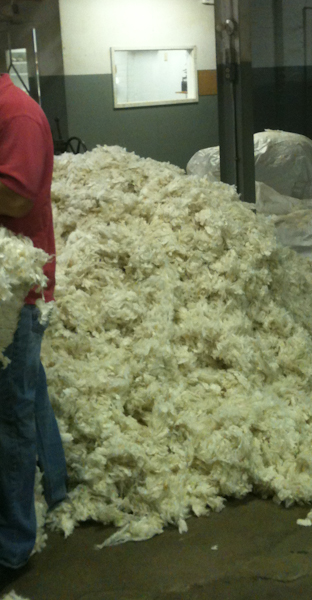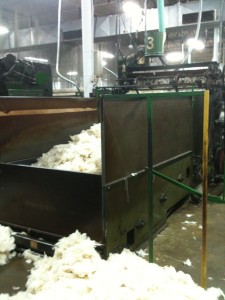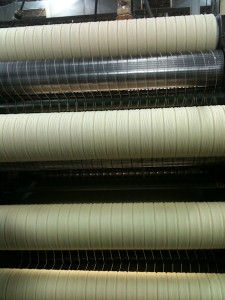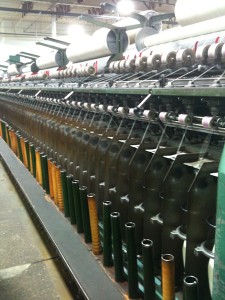A couple of weeks ago I was lucky enough to be invited along on a tour of a working woolen mill. The Faribault Woolen Mill was opened in 1865 and has been in nearly continuous operation since then. You can learn a little more about it, if you are curious, at the website. The mill was closed for a while and the building flooded but it just recently re-opened with enthusiastic new management. The people I met and talked to while I was there are passionate about what they do and really excited about all of the new things that are happening. The whole building had a positive feeling. They aren’t really open for public tours yet, so I was really delighted to have been invited along.
We started our tour in the basement of the building where the wool comes in and is processed. I was amazed that they are actually able to do everything from dyeing to spinning to weaving all in the same building. They are currently buying wool that is cleaned and baled, but eventually hope to have the machines back up and running that can process raw fleeces so they will really be back to doing every step. They have a large dye area where the wool is custom dyed either in their “signature” colors or in custom colors for special orders.
 This is one of the bales of wool being pulled apart. They start out as about 3 foot cubes that weigh 900 lbs. They say that a blanket takes about 6 lbs, so that’s 150 blankets out of one cube. That’s some densely packed wool! They told us that right now they are working with merino, romney and ramboulliet because those have the right length fibers for their equipment.
This is one of the bales of wool being pulled apart. They start out as about 3 foot cubes that weigh 900 lbs. They say that a blanket takes about 6 lbs, so that’s 150 blankets out of one cube. That’s some densely packed wool! They told us that right now they are working with merino, romney and ramboulliet because those have the right length fibers for their equipment.
This is the start of one of the spinning machines. The wool travels through a series of about 3-4 carders and comes out the other end as tiny beautiful even pencil roving, wound on big rolls. Each roll is about 10 inches in diameter and is made up of about 30 individual strands.
These then move over to the spinning machine to put the twist in and make it in to yarn. These end up being about the weight of size 8 perle cotton. You can see the large rolls on the very top and the roving is spun and then wound on to more bobbins at the bottom.
Finally, it makes its way over to the large looms. This one was working away at flag blankets while we watched.
There are several more steps to finishing, fulling, making fringe, adding labels etc that we didn’t tour this time, but I am hoping to see on another trip. I was completely enthralled through the whole tour. We also learned about how they are developing ingeo fiber, made from corn, that they are combining with the wool. Ingeo has all kinds of great properties that really compliment wool, so they are excited about the possibilities for that. I came right home and ordered two blankets from their online shop and I am completely in love.





